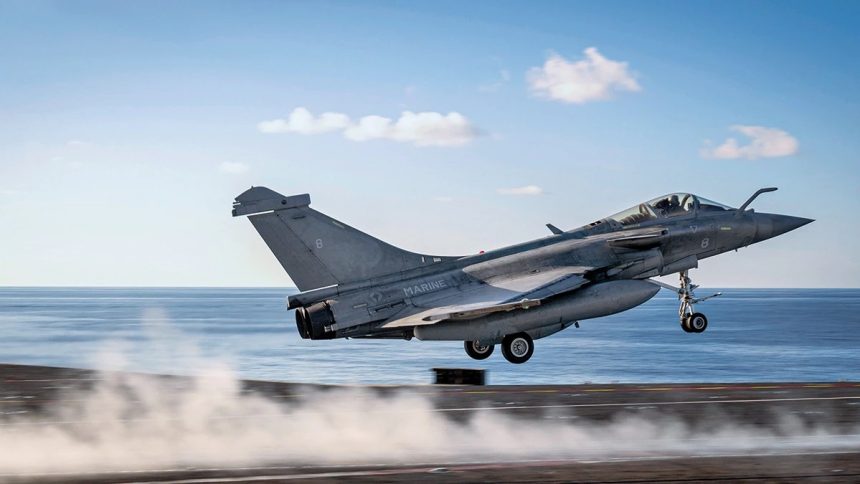The Rafale M acquisition meets the immediate capability needs for the Indian Navy’s aircraft carrier until India’s indigenous Twin-Engine Deck-Based Fighter is fielded.
India signed an Inter-Governmental Agreement (IGA) with France for the acquisition of 26 carrier-capable Dassault Rafale Marine fighters for the Indian Navy’s (IN) aircraft carrier on Apr. 28, 2025. The signing was supposed to happen during French defense minister Sebastien Lecornu’s visit to India, however the visit was deferred to a later date and the signing was done virtually, with officials later exchanding signed copies of the documents in Delhi.
Along with the 36 aircraft already in service with the IAF (Indian Air Force), this deal takes the total number of India’s Rafale fleet to 62 aircraft. This also makes the Indian Navy the Rafale Marine’s first foreign user outside France, and India the first country to operate both variants of the fighter.
#DassaultAviation : Signature du contrat #Rafale Marine pour l’Indehttps://t.co/N8heA0MbNu
Signature of the Rafale Marine contract for Indiahttps://t.co/6okzTnMz5p pic.twitter.com/UpNVY71sRy
— Dassault Aviation (@Dassault_OnAir) April 28, 2025
The contract
The contract includes the procurement of 26 aircraft, of which four would be twin-seat Rafale DH variants, relegated to the shore since a two-seater carrier capable Rafale Marine was never developed. The remaining 22 single-seat jets will be deployed on the domestically built INS Vikrant aircraft carrier.
Other components of the deal include weapons, simulators, spares, crew training and five years of logistics support. India Today added that the agreement also includes retrofitting 10 of the IAF’s 36 Rafales with buddy refueling equipment.
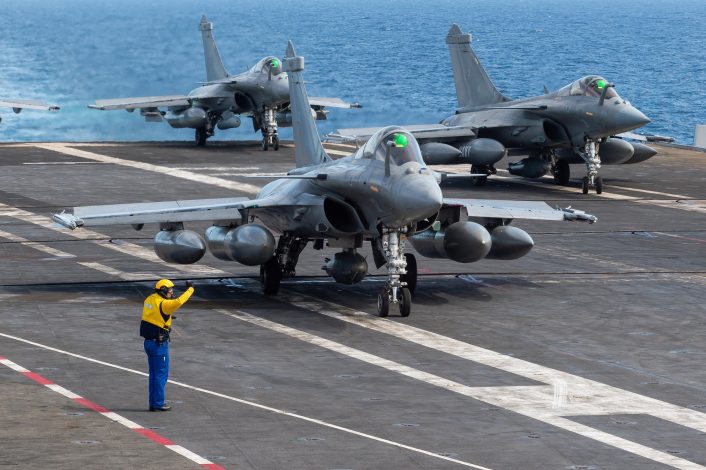
“The Rafale Marine will provide the Indian Armed Forces with state-of-the-art capabilities and the Indian Navy will benefit from the experience of the French Navy, which already operates this aircraft,” a statement from Dassault Aviation said. “Along with the 36 Rafale [two squadrons] already in service with the Indian Air Force, the Rafale Marine will play an active role in guaranteeing national sovereignty.”
The agreement also requires Dassault Aviation to allow “Transfer of Technology for integration of indigenous weapons in India,” the press release from the Indian MoD said. These include a series of homegrown air-to-air and air-to-ground systems developed by the state-owned DRDO (Defense Research Development Organization).
“It also includes setting up of production facility for Rafale Fuselage as well as Maintenance, Repair and Overhaul facilities for aircraft engines, sensors and weapons in India,” the statement added.
As already mentioned the IGA was signed virtually by Indian Defense Ministry Raksha Mantri Shri Rajnath Singh and Minister of Armed Forces of France Mr Sebastien Lecornu. Later, the signed copies of the agreement, aircraft package supply protocol and weapons package supply protocol were exchanged by Indian and French officials in the presence of Defence Secretary Shri Rajesh Kumar Singh at Nausena Bhawan, New Delhi, mentioned the press release.
Ministers @SebLecornu & @RajnathSingh graced the signing of an Intergovernmental Agreement for the purchase of 26 #Rafale Marine fighter jets for @indiannavy.
A historic moment reflecting the deep trust between 🇫🇷 & 🇮🇳, and our shared commitment to strategic autonomy. pic.twitter.com/rEkUpOHONb
— French Embassy in India 🇫🇷🇪🇺 (@FranceinIndia) April 28, 2025
India had eyes set on the Rafale
A factor that reportedly influenced the IN’s choice of the Rafale Marine, despite the jet not having folding wings like other carrier-capable aircraft, is the wide commonality of parts with the IAF’s existing Rafale fleet. This is expected to ease logistics, spares supply chains and cheapen some life cycle costs.
There had been direct indications that India was eventually going to settle for the Rafale Marine, beginning with the selection of the Rafale Marine in Jul. 2023. Also, Indian Navy chief Dinesh K. Tripathi released statements to India media in Dec. 2024, announcing a future deal for 26 Rafale Marines at a cost of Rs. 60,000 crore ($7.2 billion).
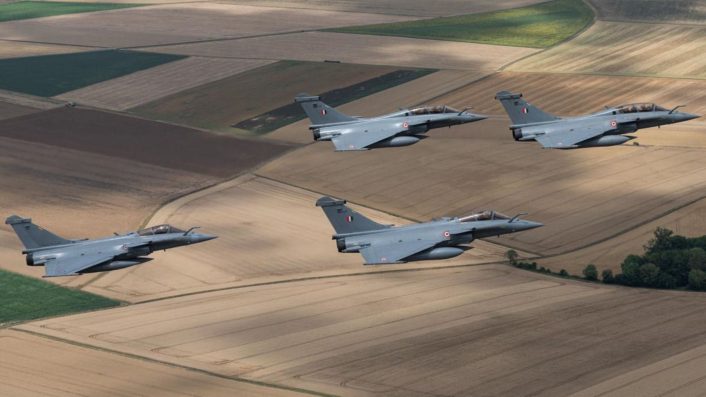
This was then followed by Rafale Ms from the Marine Nationale’s aircraft carrier FNS Charles De Gaulle conducting exercises with the Indian Navy and Indian Air Force’s Jaguar strike fighters and the Su-30MKI early in Jan. 2025, during the early phase of the French Clemenceau 25 deployment.
#CLEMENCEAU25 After a stopover in Goa and Kochi, the #French_CSG conducted sea and air activities with the @indiannavy ➡️Symbol of strong and sustainable cooperation between 🇫🇷🇮🇳 ahead of the 42nd annual bilateral #VARUNA exercise. https://t.co/TvlVt0Neo3 pic.twitter.com/mVbFLG8LEm
— French Carrier Strike Group (@French_CSG) January 10, 2025
These short drills were ahead of the larger Varuna bilateral naval exercises. The 23rd edition of the exercise was held in March 2025 and saw the Indian Navy and the French Navy conducting naval and air drills which involved the Rafale M and the the navalized MiG-29K.
Indo-French #Varuna Naval Exercise 2025🇮🇳🇫🇷 pic.twitter.com/NiOTRRpxhg
— News IADN (@NewsIADN) March 24, 2025
The exercise included “advanced air defence drills and fighter exercises, including mock air-to-air combat between the French Rafale-M and Indian MiG-29K, designed to refine tactical and operational capabilities,” mentioned the press release by the Indian Defence Ministry. The exercise also includes anti-submarine warfare components that provided “rigorous training in underwater domain awareness,” as well as surface warfare operations, maritime patrol aircraft operations, and replenishment-at-sea exercises.
The first of the 36 units of the Rafale already employed by the Indian Air Force began reaching India in mid-2020, while Pakistan began receiving its Chinese J-10CEs two years later, signaling another round of arms build-up.
The PAF has reportedly already chosen the J-35 stealth fighter as its first fifth-generation jet, while India’s homegrown stealth fighter AMCA (Advanced Medium Combat Aircraft) and the LCA (Light Combat Aircraft) Tejas Mk2 are still largely in the drawing board stage.
Indian aircraft carriers
The Indian Navy currently has two aircraft carriers, the INS Vikramaditya and the INS Vikrant. The former is a retired Soviet-era carrier, the Admiral Gorshkov, that was heavily modified and reconstructed, and finally delivered to the Indian Navy in 2013.
The carrier operates the MiG-29K carrier-borne fighter, which itself has been facing issues, primarily stemming from its RD-33 turbofan engines, airframe maintenance and a series of serviceability and parts availability problems. India ordered 12 MiG-29K and four MiG-29KUB twin-seat variants in 2004, with the first deliveries five years later. A second batch of 29 aircraft was later ordered.
F 18 Super Hornet at Shore based Test Facility, GOA India 🇮🇳
F 18 vs Rafale M 🔥🔥 pic.twitter.com/33kEaNS1gL
— Vivek Singh (@VivekSi85847001) July 24, 2022
The second carrier is the domestically built STOBAR INS Vikrant, which was supposed to operate the LCA Navy variant that the Indian Navy has been unwilling to acquire, primarily owing to the woefully unpowered single-engine configuration. Reports from 2017 said this carrier has lifts designed for both the MiG-29K and the LCA Navy.
In this regard, sources have also said that Dassault Aviation will showcase a Rafale M with Indian specific enhancement in 18 months. Whether the Indian Navy would also work with the CSL (Cochin Shipyard Limited) to undertake structural changes on the INS Vikrant remains to be seen.
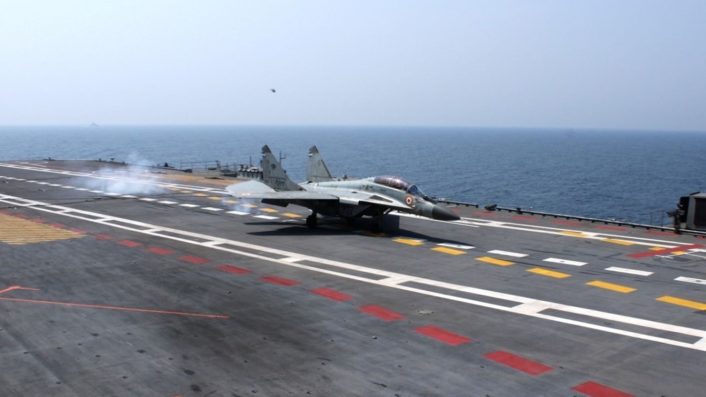
The Rafale M acquisition is also effectively an interim program for the carrier until India develops its own indigenous carrier-capable jet under the TEDBF (Twin-Engine Deck-Based Fighter) program. Nevertheless, both the Rafale and the other contender, the F/A-18 Super Hornet, have demonstrated their STOBAR ability from the Shore-Based Test Facility (SBTF) at Indian Naval Station (INS) Hansa, on India’s western seaboard in January and July 2022, respectively.
As for the locally-made weapons to be integrated on the Rafale Marine, some of them would certainly be the Astra Mk1 and Astra Mk2 BVR AAMs (Beyond Visual Range Air-to-Air Missiles) and the NASM-MR anti-ship cruise missile.
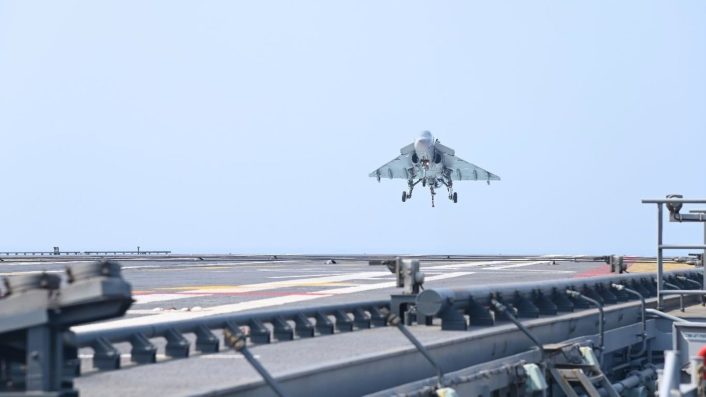
Controversial defense programs
It is a different matter that the 2015 direct contract to Dassault for the 36 Rafales came after the cancellation of the 126 aircraft MMRCA (Multi-Medium Role Combat Aircraft) program. On that occasion, Dassault was down-selected among international vendors and would have seen most of the aircraft manufactured within the country with significant ToT (Transfer of Technology).
The announcement of a subsequent MRFA (Medium Role Fighter Aircraft) program, which was essentially a duplication of the MMRCA effort, remains one of the most controversial political decisions in Indian military planning, affecting its defense industrial base and military preparedness to this date.

